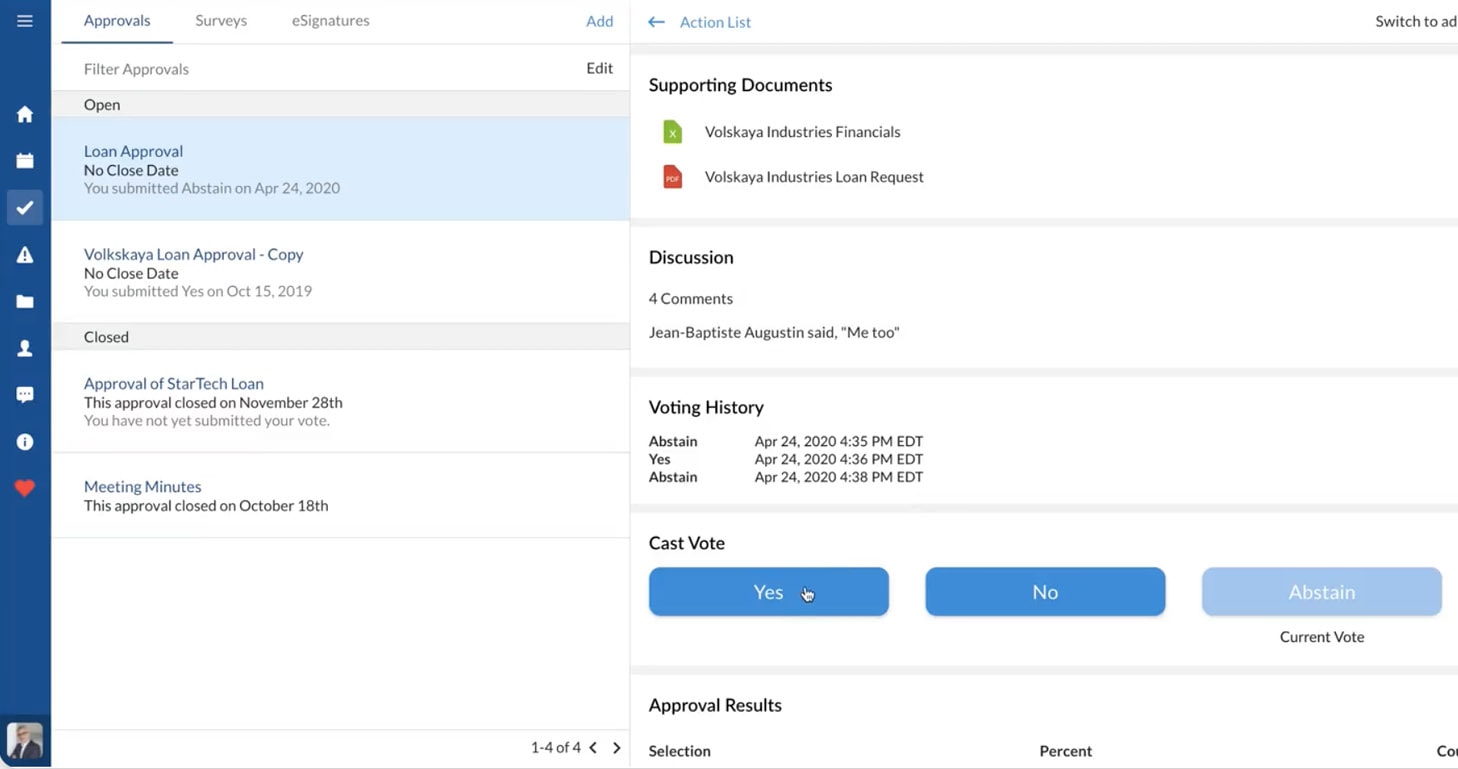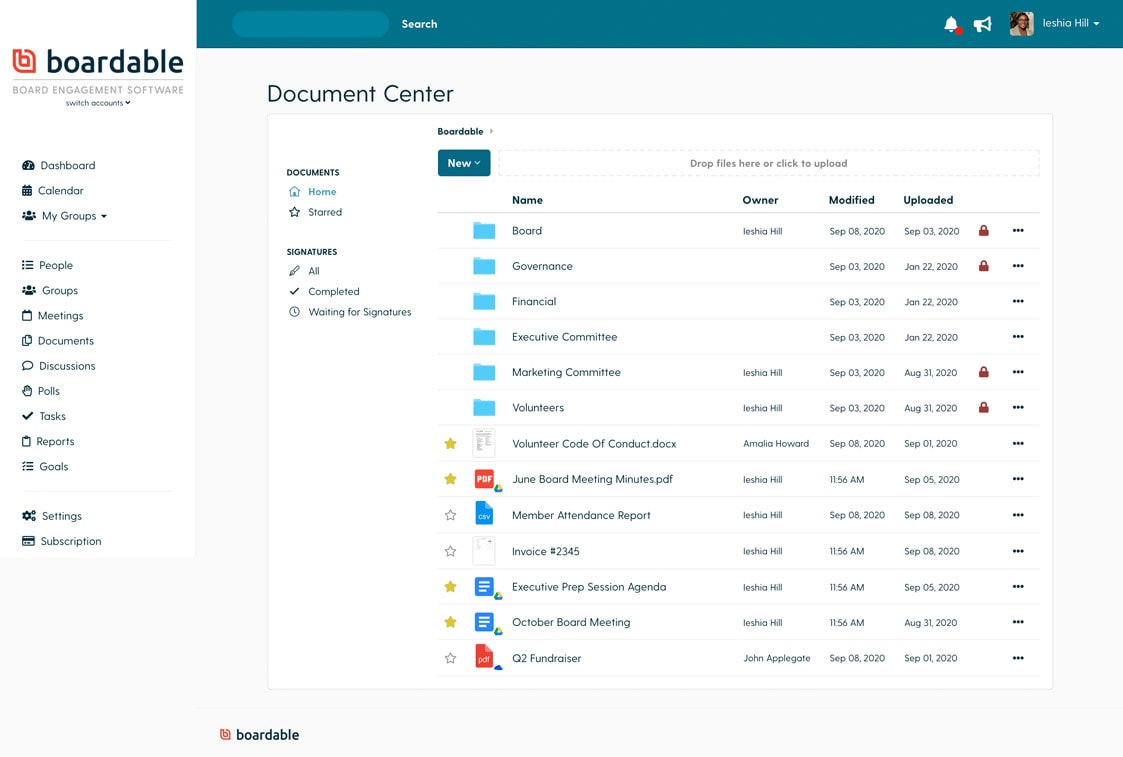
Getting your nonprofit board more engaged during virtual meetings

Face-to-face meetings for a nonprofit’s board of directors can already be challenging. Move that meeting to the digital realm and you multiply the already existing issues, especially now more than ever.
Nonprofit and foundation board members are often giving up lunch hours or time from their job to help provide oversight and guidance. Some people in attendance may have their minds elsewhere, while others hardly participate in the discussion at all.
So the question is how do you keep your virtual board meetings engaging? How do you work towards the best possible nonprofit organizational health?
To answer that question, you need to understand the challenges involved during such meetings and what are the appropriate solutions that you can potentially use to mitigate them.
Table of Contents
The challenges that you should address
There are several challenges that you should cover before the virtual meeting commences. Here are three of the biggest issues that you should prepare solutions for:
- Tech problems – Such as members getting connected to Zoom or Microsoft Teams
- Security and privacy – Moving board meetings online means it’s a lot easier for outsiders to get in, or for board members to accidentally make a meeting public
- Low engagement – This is the number one issue, of course, keeping your board members from being too distracted by the other items on their phone or computer
Tech problems and board member engagement
It can be very discouraging for a board member who experiences technical difficulties during these virtual board meetings. The board of directors should be able to get into these online meetings as quickly as possible. You don’t want to waste any of their time.
As a contingency measure, you might want to have 2 virtual board rooms set up just in case one of them can cause technical difficulties. For example, you can have a high-resolution board meeting open and test the connectivity of the host.
You can also test how presentations would look like a few minutes before the meeting. Check for noise, lighting, and sound problems that may occur as well.
After testing that first option, prepare a low-res virtual board room using a video conferencing system that doesn’t require a lot of bandwidth. Make sure that you won’t have any problems with that as well.
Once the meeting commences, give your nonprofit board members a few minutes to log in and get settled. They can have a few minutes for small talk and some meet and greet. Take this as an opportunity to detect any potential issues. You may even choose to play a welcome video to test the part of the presentations that will be broadcast later.
These things can increase the engagement of the attendees. They feel welcomed and you can resolve any potential technical issues before the actual meeting begins.
Having a plan for digital board meetings is one example of a digital strategy for your nonprofit.
Security and privacy issues for board meetings
Some new attendees may have concerns about the security of these virtual meetings. The news of “Zoombombing” back in April 2020 didn’t really help. However, Zoom and other providers of video conferencing tools have stepped up and improved the security of their systems.
Apart from that, your nonprofit organization should also ensure the online security of meeting participants. That includes providing the installation software of the tools that your team will be using and others.
You should also check the security of your selected video conferencing platform as well.
When people have security concerns regarding these meetings, expect them to be less engaged. Some may not even attend these virtual board meetings at all. Take the time to explain the measures that you have taken, and assure them that their information will remain safe and intact.
There are also purpose-build virtual board meeting systems that add an extra layer of security if you’d prefer to avoid software like Zoom or GoToMeeting.
Board engagement tips for success
When it comes to board engagement, there are several solutions that you can apply. Some of them are preemptive and some of these measures can be applied as the meeting goes on.

Here are some of our tips for getting your nonprofit board more engaged during your online meetings.
Tip #1–Consider adding new members to the board
You know what they say: sometimes, you need to infuse new blood into an organization to keep things rolling—or something to that effect. Note that this is one of the preemptive solutions.
You see, if you bring in a new guy into the picture, the people who have been into these meetings a hundred times or more will have something interesting to look forward to. These new people can give new insights that can increase meeting engagement and focus.
Of course, you don’t want to make the onboarding of the new people to be a big surprise to everyone in attendance. You can make the announcement beforehand and even introduce the new member through an email or memo.
It’s a way to build up some anticipation before the next meeting.
But how do you find the right people to add to the existing board members of your foundation?
Here is a few tips:
- Create a list of potential candidates
- You can even ask for recommendations from your current board members too, which of course increases their participation in the upcoming meetings as well
- Look for specific qualities that you look for in an exemplary board member
- Screen the people in your list, which means reaching out to them and asking them if they would like to be part of the board in your nonprofit
- Conduct your interviews as carefully as you can. Discuss the roles that the candidate will be taking and what is expected of them.
- Don’t choose the new board members by yourself. Create a nominating committee—which also increases engagement within your current team.
Adding a new member to your nonprofit board can cause a bit of excitement. But the job isn’t over after having them onboard. You need to involve your new member and have them work with other members of the board to increase camaraderie and cooperation within the team.
Tip #2–Determine board meeting frequency and agenda items beforehand
Your board members may lose interest in these meetings if you hold them too frequently. Again, remember that these are very busy folks, and they also need to spend time with other enterprises and interests that they may have.
Remember that the frequency of these meetings is under the discretion of all the members of the board. It could be stated in the organization’s bylaws, it can be based on the needs of your organization, and it can also be agreed upon by board members as well.
The following are a few reminders and tips that might help with this:
- Determine the number of reports that will be presented beforehand. This allows you to determine how long each meeting will be, and if you need to schedule additional meetings for the other reports.
- See if you can put agenda items into short reports that can be emailed to the board members so that you can decide on the matter rather quickly.
- Communicate the dates of the scheduled meetings beforehand so that board members can agree to cancel certain meetings or move meetings to a later date.
Tip #3–Keep your meeting’s agenda tight
Someone once said that we sometimes spend too much time sitting in meetings and end up thinking we’re being productive. When you sit and meet too long instead of going out and getting things done, you’re not really getting productive at all.
Again, as a team, your board members need to act on issues and make decisions fast. If your team sits there without passing resolutions, then you’re just wasting your time. Keeping your board meetings tight will benefit your organization as a whole, and it saves the time of your members as well.
Here are some ideas that might help you spend more quality time during such important meetings:
- Distribute agenda beforehand. You don’t need to make the agenda a surprise to your board members. Send them beforehand so that the attendees will know what to expect and formulate their own thoughts about the issues and decisions that need to be made come the day of the meeting.
- Limit unnecessary discussions. Your board members can become good friends as time goes by, and as they interact more with one another. Quarantine and social distancing protocols also make people want to do some chit-chat as well. If that is the case, you can allow members of your board to log into the virtual board meeting five to 10 minutes before the appointed time to allow for some chitchat. You can then ask those in attendance to focus on the agenda items once the meeting commences.
- Assign the roles of each participant beforehand. You save time when you assign the roles of each board member days before the actual meeting. This allows them to prepare for their parts as well. They can prepare the necessary reports, research the data, and prepare other pertinent information for the meeting. You can assign who will be the facilitator of the meeting, the note taker, the timekeeper, and other roles as well. These roles should also be indicated in the agenda as well.

- Use polling tools prior to the meeting to allow you to determine the sentiment of the board members before the meeting commences. Using these tools can help the members of your board to make important decisions quickly. You can choose to provide the results of these virtual polls before the meeting or just reveal the results during the meeting.
- Use scheduling tools to remind board members of the items in your agenda. They can also nominate which subject matter should be discussed first. The team itself can also use these tools to set up reminders as well.
Tip #4–Make important materials accessible within your portal
The official web portal of your foundation should allow board members exclusive access to important materials throughout the workweek. Document management tools will help your team understand issues before the actual meeting.
Here are some of the materials that you should make accessible:
- Audit reports
- Minutes of previous meetings
- Committee charters
- Agendas of previous meetings
- Financial reports
- Committee reports

Tip #5–Allow for communications in between board meetings
You can also increase board engagement during the meeting if board members can discuss certain matters outside of the meetings. This will allow them to better present data and information more effectively.
Getting your nonprofit board more engaged requires that you involve the entire team in the preparation and everything else going that will go on during such meetings. The good news is that there are tools that you can take advantage of to make these engagements truly interesting.
Looking for more tips on having the best virtual board meeting possible? View our virtual board meeting tips article.
